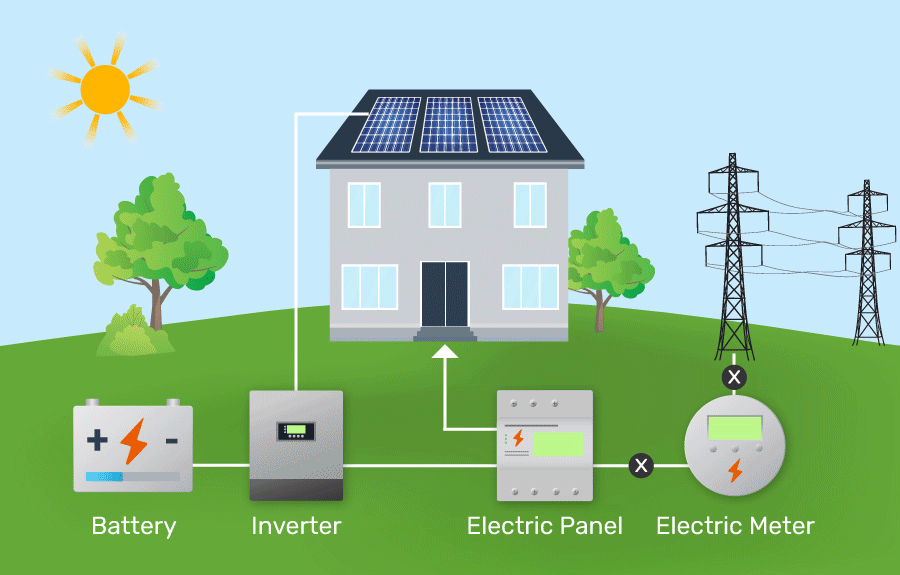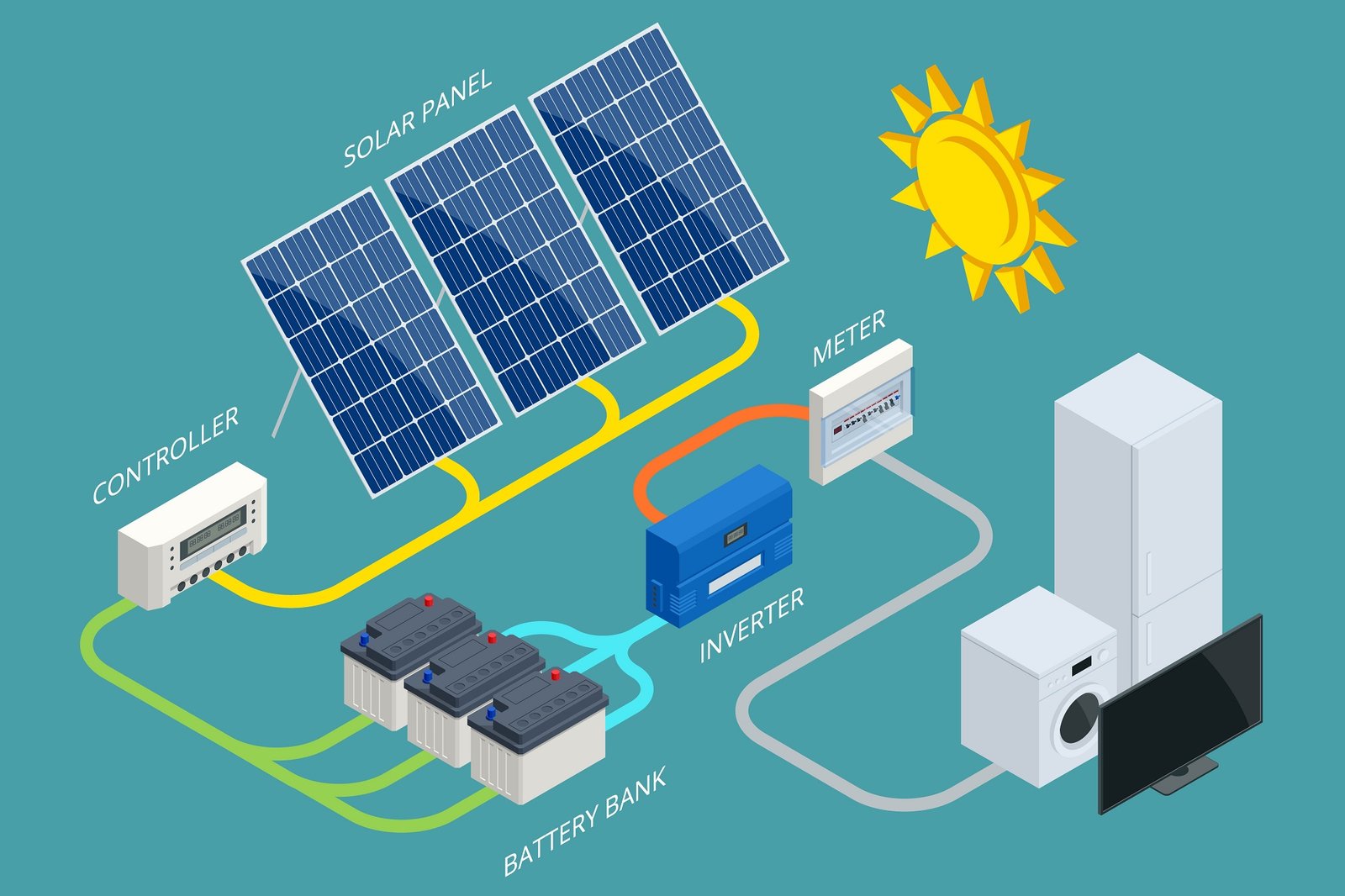Solar batteries are changing the way homes and businesses in India use solar power. They help store extra electricity from the sun and use it later—especially during power cuts, at night, or on cloudy days. But how do solar batteries really work?
This guide explains the working principle, battery types, and how they fit perfectly in India’s growing solar energy movement.
What Is a Solar Battery?
A solar battery is a device that stores unused energy generated by your solar panels. Instead of letting this energy go to waste or sending it to the grid, the battery saves it for later. This stored energy can be used during load shedding, power failures, or night-time use when your panels are not producing electricity.
Solar batteries make solar energy more reliable, especially for people in remote or rural parts of India where grid power is not always available.
Working Principle: How Does a Solar Battery Work?

Let’s break it down simply.
- Sunlight hits your solar panels.
- Panels generate DC (direct current) electricity.
- A solar charge controller regulates the power and sends extra electricity to the battery.
- The battery stores the energy as chemical energy.
- When needed, this stored energy is converted back into AC (alternating current) using an inverter.
- This AC power runs your appliances at home or office.
So, a solar battery acts like a backup tank for electricity. It makes sure you don’t waste the power your solar system produces.
Types of Solar Batteries in India
Choosing the right battery type is very important. Here are the common options:
🔋 Lithium-Ion Battery for Solar
- Most efficient and long-lasting
- Lightweight and maintenance-free
- High depth of discharge (DoD)
- Ideal for rooftop solar systems in Indian homes
- Lifespan: 10 to 15 years
- Slightly expensive but offers better value in the long term
- Popular choice: Lithium Iron Phosphate (LFP) due to safety and stability
🔋 Lead-Acid Solar Battery
- Lower cost option
- Needs regular maintenance and ventilation
- Shorter lifespan: 3 to 5 years
- Larger in size and heavier
- Best for off-grid solar setups in rural areas
🔋 Flow Batteries
- Used mostly in commercial and industrial setups
- High life cycle and large capacity
- Ideal for large-scale solar energy storage in India
- Expensive and bulky—less suitable for homes
Also Read Power Up Smart: How to Estimate Your Business’s Energy Needs in India
Why Should You Use Solar Batteries in India?
India faces frequent power outages and grid instability in many areas. Here’s why solar batteries are a great fit:
- 24×7 solar power: Use stored energy at night or during cloudy weather
- Backup during load shedding: Especially helpful in Tier 2 and Tier 3 cities
- Less dependency on grid: Enjoy energy freedom
- Lower power bills: Use solar energy more effectively
- Supports rooftop solar with no net metering: Store excess power instead of sending it to the grid
- Eco-friendly: Reduces fossil fuel use and carbon footprint
Major Indian states like Gujarat, Maharashtra, and Tamil Nadu are investing in large solar battery storage systems to improve energy reliability.
Choosing the Right Solar Battery System
If you’re planning to install a solar battery in India, consider these factors:
1. Battery Capacity
Choose a battery size that matches your daily energy consumption and backup needs. A typical Indian home may need 5 kWh to 10 kWh storage.
2. Depth of Discharge (DoD)
Higher DoD means more usable energy. Lithium-ion batteries offer 90%+ DoD while lead-acid batteries give around 50%.
3. Battery Efficiency
Lithium-ion: 90–95%
Lead-acid: 75–85%
Higher efficiency means less energy loss.
4. Lifespan & Warranty
Check the cycle life and years of warranty. Lithium-ion batteries last up to 6,000+ cycles. That’s over 10 years of use!
5. Space & Ventilation
Lithium-ion batteries are compact. Lead-acid batteries need more space and airflow for safety.
AC vs. DC Coupled Solar Battery Systems
Your installer may suggest either of these:
🔌 DC-Coupled System
- Solar panels charge the battery directly
- Higher efficiency
- Good for new installations
🔌 AC-Coupled System
- Power flows through the inverter before charging the battery
- Easier to add to existing solar systems
- Slightly less efficient but more flexible
Solar Battery Maintenance in India
- Lithium-ion: Minimal care needed
- Lead-acid: Regular water top-ups, checks for corrosion, and temperature control
- Install batteries in a cool, dry, and ventilated space
- Protect from extreme Indian summer heat to extend battery life
Is a Solar Battery Worth It?
Yes—especially in places with:
- Frequent power cuts
- Unstable grid supply
- High electricity tariffs
- No or partial net metering
- Backup power needs
With falling prices and government push for solar, solar energy storage systems in India are becoming more affordable and common.
FAQs About Solar Battery Working in India
Q1: Can I run my home only on solar battery?
Yes, if you have a large enough system. You’ll need sufficient solar panels and battery capacity.
Q2: Which solar battery is best for Indian homes?
Lithium-ion batteries offer the best value for home solar systems. They are durable, efficient, and compact.
Q3: Do solar batteries work in monsoon or cloudy weather?
Yes. Batteries store power from sunny days and provide it when production is low.
Q4: How much does a solar battery cost in India?
Prices vary. A 5 kWh lithium-ion solar battery may cost ₹1.5 to ₹2.5 lakhs. Prices are expected to fall as demand grows.
Q5: Can I add a battery to my existing solar system?
Yes. AC-coupled systems make it easy to add batteries later.
Final Thoughts
Solar batteries are the backbone of smart solar systems. They store power, reduce bills, and provide energy security during outages. Whether you’re setting up a new solar plant or upgrading your existing system, a solar battery in India can add value, comfort, and reliability.
Make sure to consult a certified solar installer who understands your energy needs, location, and budget. A properly planned solar battery system will power your home long after the sun goes down.










